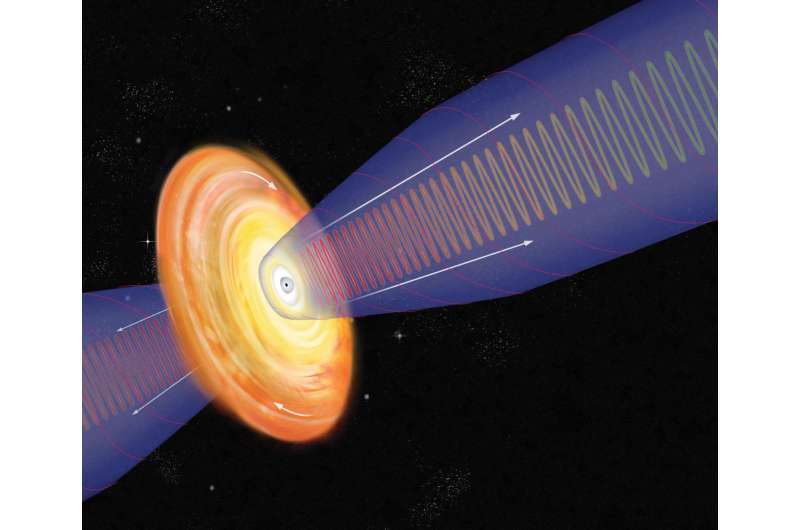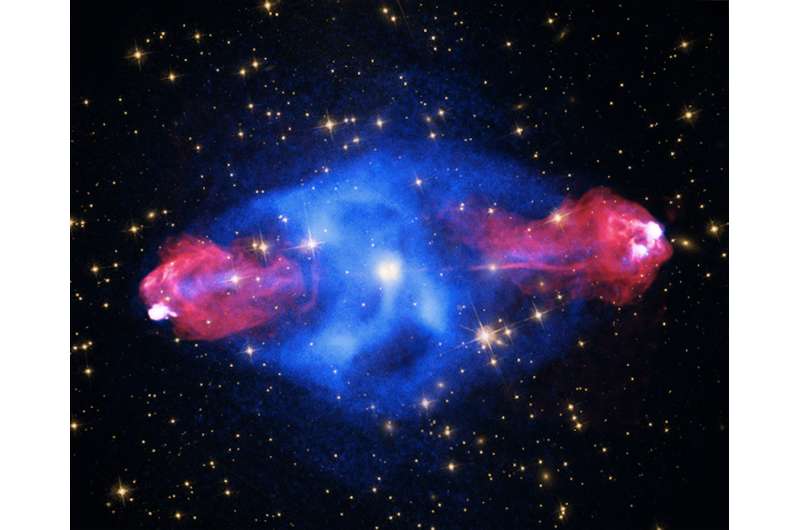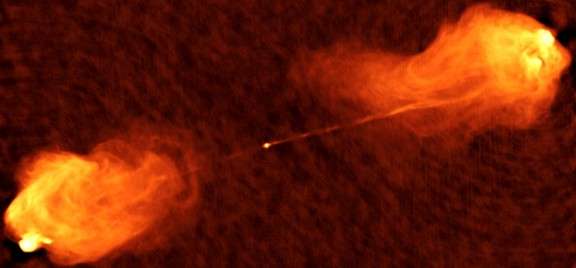A famous supermassive black hole observed with the Gran Telescopio CANARIAS

Cygnus A is an elliptical galaxy around 600 million light years from the Earth, which has a supermassive black hole at its centre. It is one of the brightest sources of radio waves in the sky and was featured in Contact, the famous science fiction novel by Carl Sagan, which was made into a film. It has an active galactic nucleus, which means that the black hole is "swallowing" material from its surroundings. When this occurs, strong electromagnetic radiation is produced, as well as large jets of particles, which are emitted from the galactic nucleus at near the speed of light, traveling beyond the edge of the galaxy and reaching three hundred thousand light years into the intergalactic medium.
This is the first time that polarimetric observations in the middle infrared region of the spectrum have been made of the nucleus of an active galaxy. "The combination of the Gran Telescopio CANARIAS (GTC) and CanariCam offers unique capabilities for the observation of active galaxies using polarimetric techniques in the middle infrared," explains Enrique López Rodríguez, a researcher at the University of Texas in Austin (EE UU) and the first author of this study, published in the Astrophysical Journal. "There is no other comparable instrument of this kind," he says. "And no such instruments are expected until the next decade, because the instruments that are being developed now cannot make polarimetric measurements."
Polarimetry is a technique to observe the intensity and the orientation of electromagnetic waves. "If the observed radiation is polarized in a given sense and with a given dependence on wavelength, we can obtain information about the physical mechanisms that produce the polarization. This technique helps us squeeze out the last drop of information from each photon picked up by the GTC," says López Rodríguez.
"Polarimetry," he adds, "lets us eliminate from the observations all the light that is not affected by the magnetic field in the active nucleus, so that we can filter out everything that comes from other sources, such as the galaxy itself, or background stars. This gives us a much higher contrast when we observe the jets and the dust in the galaxy, while studying the influence of the magnetic field on both of them."

On the basis of these observations, the astronomers have detected that the plasma ejected from the active nucleus is spiraling around the magnetic field of the jet, which generates a type of radiation known as "synchrotron radiation," produced by the rapid movement of electrons around magnetic fields. Although this phenomenon had been observed previously at other wavelengths, this is the first time it has been detected in the middle infrared, which has enabled confirmation that the plasma in the jet of Cygnus A is highly confined by the effect of the magnetic field. These observations reveal valuable information about the configuration of the magnetic field in the neighbourhood of the black hole that cannot be directly observed.
A cosmic jigsaw
Astronomers classify Cygnus A as a radiogalaxy because it is one of the most powerful radio sources in the sky. It was observed for the first time in 1939 and it is named because it is the strongest radio source in the constellation of the Swan (Latin name Cygnus). Nevertheless, this galaxy emits radiation over the full range of the electromagnetic spectrum, which makes it an ideal astronomical laboratory, and one of the favourite objects of astronomers, who have been making observations with diverse instruments and at different wavelengths, interpreting them to compose the pieces of a cosmic jigsaw, which will let us understand better what is happening in that region of the universe.

Cygnus A has a very complex structure, which includes a compact nucleus and opposed jets of matter emitted from the centre of the galaxy toward the edges, all shrouded in a mantle of dust with an irregular structure that is impenetrable to visible light. "It is a paradigm galaxy for studying the formation and evolution of jets, because the dust completely obscures the centre of the galaxy, so that we cannot detect well the light emitted by the jets," explains López Rodríguez. This is why the research team has used CanariCam, and instrument designed to detect infrared radiation, which is not blocked by interstellar dust.
The Gran Telescopio CANARIAS is uniquely equipped to make these observations. Thanks to its large primary mirror, which favours high spatial resolution, and the CanariCam instrument, which can observe in the middle infrared wavelength range, scientists can study the infrared radiation emitted by the galaxy. This emission comes from matter that is not hot enough to emit visible light, but is warm enough (around 220K, or -53ºC) to emit infrared radiation. In addition, the polarimetric capability of CanariCam provides an additional dimension of information, which astronomers can analyze to interpret different physical mechanisms.
Until now, very little has been known about the polarization of the infrared radiation emitted by the supermassive black holes at the centres of the majority of galaxies. Astronomers hope that these and similar observations can provide new data that will help them to understand the mechanisms causing the activity of these cosmic monsters, and their influence on the galaxies they inhabit.
More information: E. Lopez-Rodriguez et al, POLARIZED MID-INFRARED SYNCHROTRON EMISSION IN THE CORE OF CYGNUS A, The Astrophysical Journal (2014). DOI: 10.1088/0004-637X/793/2/81
Journal information: Astrophysical Journal
Provided by Instituto de Astrofísica de Canarias (IAC)



















